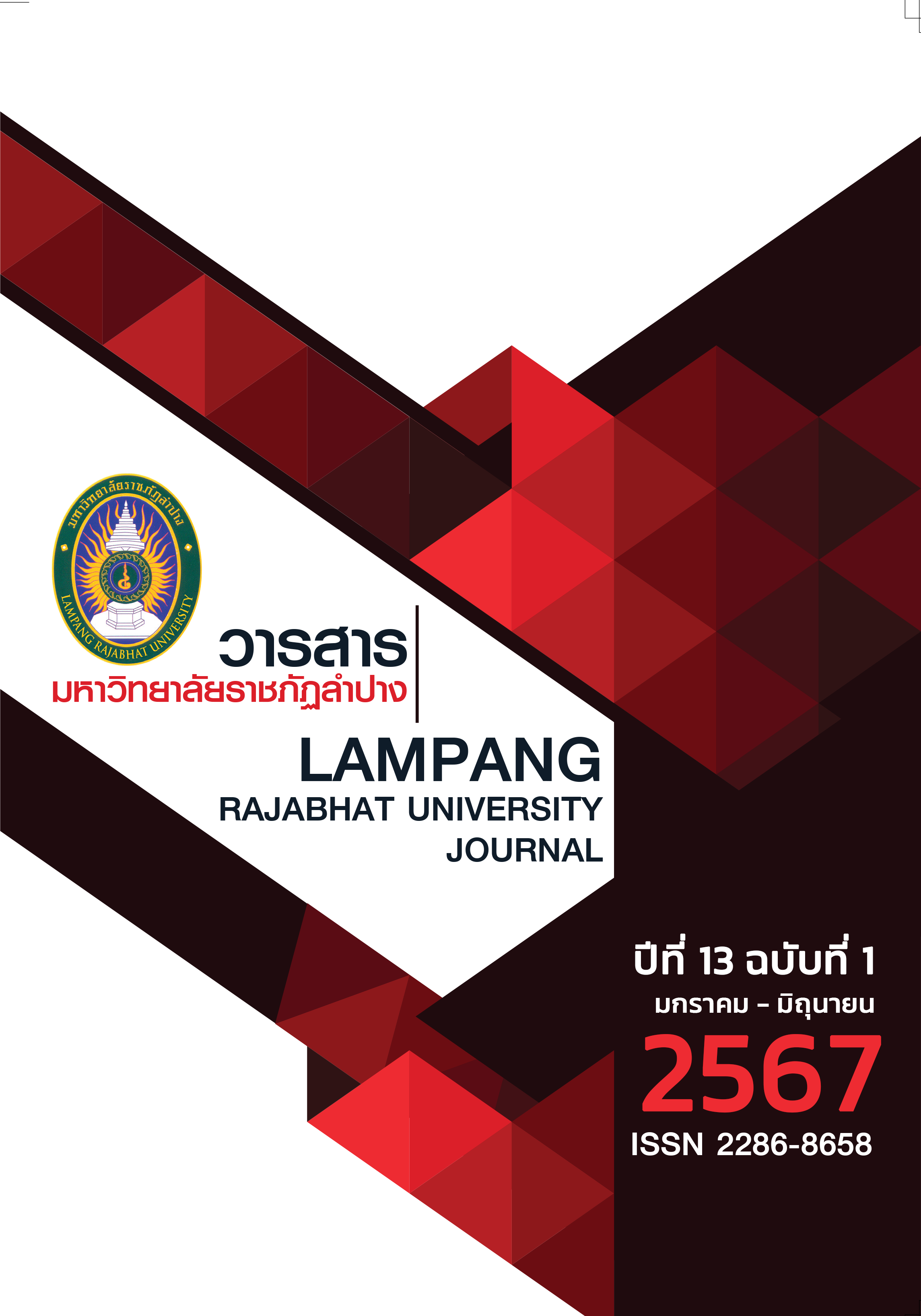The Study Effects of Media Development Using Sound-to-Image Technology on the Learning Achievement of Students with Hearing Impairments in Udon Thani Province
Keywords:
Sound-to-Image Technology, Hearing Impairments, Learning AchievementAbstract
This quasi-experimental research aimed to study the effect of media development using sound-to-image technology on the learning achievement of students with hearing impairments in Udon Thani Province. The participants were 50 students with deafness of Mathayom 1 - 3 in Udon Thani School for the Deaf, Mueang District, Udon Thani Province, by purposive random sampling. The experiment tool used was a teaching medium to promote learning achievement using sound-to-picture technology. The index of item objective congruence was 0.98 and the collected data tool was the 5-level rating scale of the learning achievement assessment form for the hearing impaired. The index of item-objective congruence was 0.90. Descriptive statistics were percentage, mean, and standard deviation to describe characteristics such as gender, age, and education. Inferential statistics include the paired sample t-test to compare the average of learning achievement before and after the experiment, the Wilcoxon rank-sum test, and the Shapiro-Wilk test. Statistical significance was set at the 0.05 level.
The results found that most of the students were 27 males (54%), 23 females (46%), with an average age of 14.2 years. Most of them are studying at the Mathayom 2 level, with 18 students (36%), followed by 17 students studying at the Mathayom 3 level (34%). The learning achievement was found to be both in remembering, understanding application, analysis, evaluation, and creativity after the experiment, which were statistically significant different from before the experiment.
References
กระทรวงพัฒนาสังคมและความมั่นคงของมนุษย์. (2556). พระราชบัญญัติส่งเสริมและพัฒนา คุณภาพชีวิตคนพิการ พ.ศ. 2550 และที่แก้ไขเพิ่มเติม (ฉบับที่ 2) พ.ศ. 2556. กรุงเทพฯ: กรมส่งเสริมและพัฒนาคุณภาพชีวิตคนพิการ สำนักงานส่งเสริมและพัฒนาคุณภาพชีวิตคน พิการแห่งชาติ.
กระทรวงศึกษาธิการ. (2562). พระราชบัญญัติการศึกษาแห่งชาติ พ.ศ. 2542 และที่แก้ไขเพิ่มเติมจนถึง (ฉบับที่ 4) พ.ศ. 2562. กรุงเทพฯ: กระทรวงศึกษาธิการ.
กระทรวงศึกษาธิการ. (2551). พระราชบัญญัติการจัดการศึกษาสำหรับคนพิการ พ.ศ. 2551. กรุงเทพฯ: คุรุสภา ลาดพร้าว.
กัลยภัฏร์ ศรีไพโรจน์. (2563). การเปิดรับสื่อ การรับรู้ ความรู้ และพฤติกรรมด้านการป้องกันในสถานการณ์การระบาดใหญ่ทั่วโลกของนักเรียนมัธยมศึกษาตอนต้น: กรณีโควิด 19. นวัตกรรมรูปแบบรายการโทรทัศน์และการมีส่วนร่วมของคนหูหนวก. วิทยานิพนธ์ครุศาสตรมหาบัณฑิต คณะครุศาสตร์. จุฬาลงกรณ์มหาวิทยาลัย.
ชัยยงค์ พรหมวงศ์. (2556). การทดสอบประสิทธิภาพสื่อหรือชุดการสอน. วารสารศิลปากรศึกษาศาสตร์, 5(1), 1-20.
น้ำเพชร เทศะบำรุง. (2565). แนวทางการวิจัยและพัฒนาสู่นวัตกรรมทางการศึกษาพิเศษ. Journal of Roi Kaensarn Academi, 7(3), 334-344.
พัชรีวัลย์ เกตุแก่นจันทร์. (2540). “การจัดบริการการศึกษาของบคคลปัญญาอ่อน: การเรียนร่วมระหว่าง เด็กที่มีความบกพร่องทางสติปัญญากับเด็กปกติ”. เอกสารการประกอบการอบรมหลักสูตรระยะ สันความรู ้เรื่องภาวะปัญญาออน. กรุงเทพฯ: โรงพยาบาลราชานุกูล.
ประภัสสรา พงศ์พันธุ์พิศาล, มนทยา สุนันทิวัฒน์, สมหญิง พุ่มทอง และลือรัตน์ อนุรัตน์พานิช. (2565). ผลกระทบด้านสุขภาพจาก สถานการณ์ระบาดของโควิด 19 ต่อผู้ที่มีความบกพร่องทางการมองเห็นในเขตกรุงเทพมหานคร. วารสารวิจัยระบบสาธารณสุข, 16(2), 169-182.
สำนักงานส่งเสริมและพัฒนาคุณภาพชีวิตคนพิการแห่งชาติ. (2552). คนพิการกับสิทธิตามอนุสัญญาว่าด้วยสิทธิคนพิการ. กระทรวงการพัฒนาสังคมและความมั่นคงของมนุษย์. กรุงเทพมหานคร.
สํานักนายกรัฐมนตรี. (2551). พระราชบัญญัติการจัดการศึกษาสําหรับคนพิการ พ.ศ.2551. กรุงเทพฯ:
อักษร สวัสดี. (2542). ความรู้ความเข้าใจและความตระหนักในการอนุรักษ์สิ่งแวดล้อมของนักเรียนชั้นมัธยมศึกษาตอนปลาย: กรณีศึกษาในเขตบางกะปิ กรุงเทพมหานคร. วิทยานิพนธ์พัฒนบริหารศาสตรมหาบัณฑิต สาขาวิชาพัฒนาสังคม, สถาบันบัณฑิตพัฒนบริหารศาสตร์.
Aljedaani, W., Krasniqi, R., Aljedaani, S., Mkaouer, M. W., Ludi, S. & Al-Raddah, K. (2022). If online learning works for you, what about deaf students? Emerging challenges of online learning for deaf and hearing-impaired students during COVID-19: A literature review. Universal Access in the Information Society, 22(4), 1027–1046.
Alshawabkeh, A. A., Woolsey, M. L. & Kharbat, F. F. (2021). Using online information technology for deaf students during covid-19: A closer look from experience. Heliyon, 7(5), e06915.
Ashraf, S., Basri, S. R. & Fatima, I. (2023). Technology Used by Hearing-Impaired Adolescents for Social Inclusion: A Cross-sectional Study. Journal of Business and Social Review in Emerging Economies, 9(3),137-148.
Khasawneh, M. A. S. (2023). The use of video as media in distance learning for deaf students. Contemporary Educational Technology, 15(2), ep418.
Kilpatrick, J. R., Ehrlich, S. & Bartlett, M. (2021). Learning from covid-19: Universal design for learning implementation prior to and during a pandemic. J. Appl. Instruct. Des, 10(1), 1-17.
Utami, I. S., Budi, S. & Nurhastuti, N. (2020). A need analysis of blended learning model for deaf students in higher education. Edumatic: Journal Pendidikan Informatika [Edumatic: Journal of Informatics Education], 4(2), 112-119.
Yang, Y., Xiao, Y., Liu, Y., Li, Q., Shan, C., Chang, S. & Jen, P.H.-S. (2021). Mental health and psychological impact on students with or without hearing loss during the recurrence of the covid-19 pandemic in china. Int. J. Environ. Res. Public Health, 18(4), 1421.
Downloads
Published
How to Cite
Issue
Section
License
Copyright (c) 2024 Lampang Rajabhat University Journal

This work is licensed under a Creative Commons Attribution-NonCommercial-NoDerivatives 4.0 International License.
บทความลิขสิทธิ์ของวารสารมหาวิทยาลัยราชภัฎลำปาง





